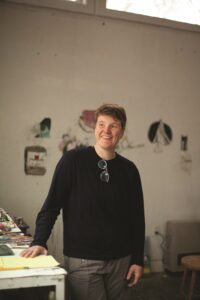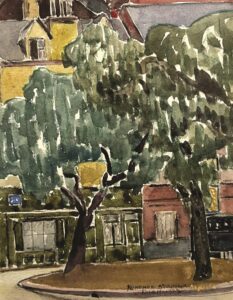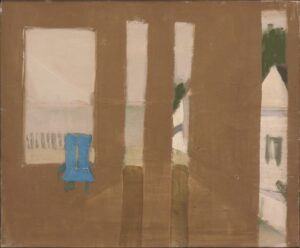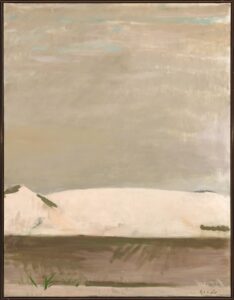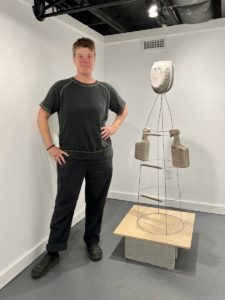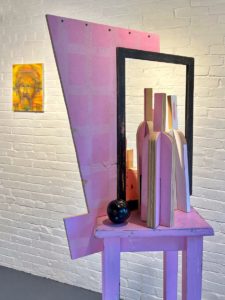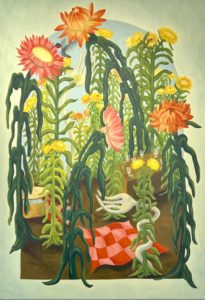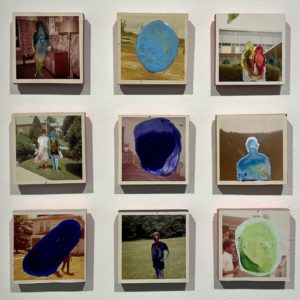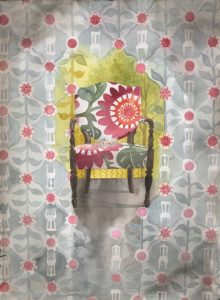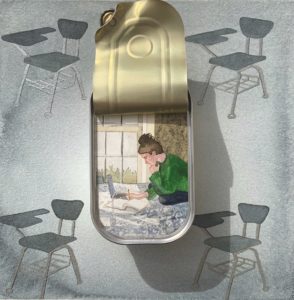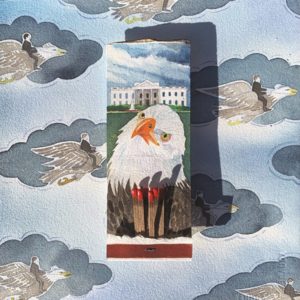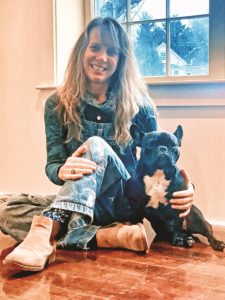Megan Hinton’s first career survey show at the Provincetown Art Association and Museum reveals an artist whose work is instantly recognizable for its strong use of line, a line that connects many disciplines: painting on canvas or found objects, printmaking, assemblage, collage, photography, sculpture, and performance. “I really wanted to include the 25 years of her work, so that you can see the trajectory and the transitions,” says PAAM CEO Chris McCarthy. Hinton will be recognized on Oct. 5 with the museum’s award for artistic excellence at this year’s PAAM Party, titled “Between Abstraction and Reality.”
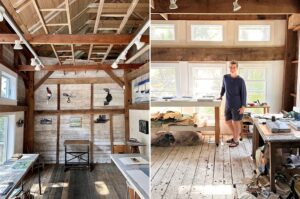
Hinton visited the Outer Cape in the summer of 2000 for one of the Provincetown Community Compact’s artist residencies at the C-Scape dune shack. She moved to Wellfleet in 2007. On a recent visit, I asked about her show and her new studio, a historic mid-19th century two-story barn that hugs the side of one of Truro’s winding roads.
Q: When I visited your barn, I was immediately struck by the strict but slightly wonky geometry of its interior and how you displayed your paintings and found objects in various nooks and crannies. How much does the barn as a building influence your work?
It does influence me subliminally. My previous studio in Wellfleet was a very architecturally clean and contemporary space. While there, I worked on geometric landscape paintings on traditional flat surfaces. Since moving into the barn studio, I notice how the crooked floors, the tilting walls, and the asymmetrical carpentry is affecting the way I look at things. Also, a lot of the found material I’m painting on now came from our house renovation, wood that would’ve been discarded otherwise.
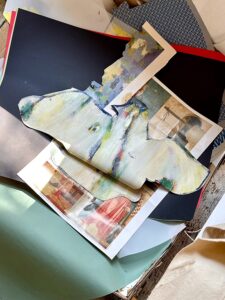
Q: Tell me about how you found the barn.
I noticed that the barn was for sale in 2020. I poked around the exterior and thought this should be an artist’s studio. Could it be my studio? My partner, Paula Erickson, and I ended up buying a place off Castle Road near the barn. Paula said it would make the perfect studio since it’s so close to our house yet at a distance.
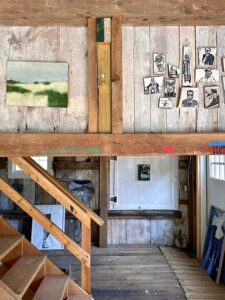
Q: You primarily work with paint, correct? It sounds like the studio is sending you toward a more dimensional, shaped painting route, almost like sculpture. Did that begin earlier?
Yes. I was always attracted to assemblage and collage because it was a new way to engage with the material. It’s very important for me to reinvent myself from time to time as an artist. I tend to work in series. I wouldn’t say I get bored quickly, but if I’m working on something for a year or more, the series ultimately becomes exhausted. There’s a lot of cutting and building involved with this new work. I have this idea of destroying to reconstruct, and that seems radical to me. Even though collage has been going on for over 100 years, it’s still a radical act to reject material and then repurpose it.
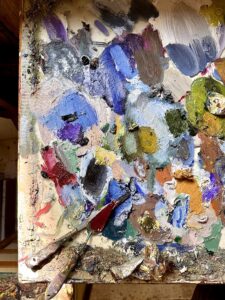
Q: And what about the work where you’re cutting up your own paintings?
I’m taking scraps or components of failed paintings, things that didn’t work out or canvas surfaces that I found. The assemblage and the constructed canvas pieces start almost like I’m arranging patterns, like a quilter. It’s a different process from painting. There’s a simultaneous reductive and additive thing happening. It’s a building up. I think of painting and adding strokes as a form of assembling. I like the idea that a painting doesn’t have to be a rectangular picture. It can be a shaped form, something more sculptural made of paper or canvas to repaint and then mount on a panel to give it support. Found wood might come into play there as well. I’m identifying as a builder of painting in some ways.
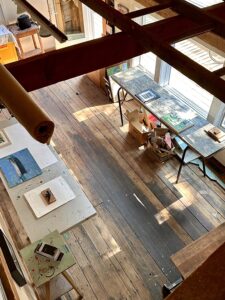
Q: For your shows, and especially your first show at PAAM, how involved are you with the presentation?
I like working with other people. My collaborator, Susie Nielsen, who directs Farm Projects in Wellfleet where I exhibit, is an acute curator. For the PAAM show, I am excited for Chris McCarthy’s layout of the show. It is eye-opening how she interprets my work with her refined vision. She came in the barn studio and picked the pieces that were not only important but connected. That’s the work of curator. Chris also has fantastic understanding of art history, not only Provincetown art history, but contemporary work, too.
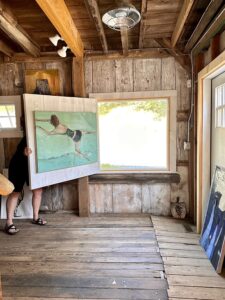
Q: How important was Provincetown’s art history to you when you arrived here? Can you name the Provincetown artists, historical or contemporary, who influence you currently?
My only knowledge of the art scene when I arrived were the big H’s: Hofmann and Hawthorne. Lately, I’ve been very interested in Biala, who was Jack Tworkov’s sister. She was active in the mid-20th century, painting landscape imagery during a time when many painters weren’t working on objective imagery at all. I also think of Karl Knaths for shape. Florence Brillinger for brushstroke. Herman Maril for distilling a picture into the simplest form while still maintaining the attitude of the scene. Victor DeCarlo for minimal abstraction. And Arthur Cohen, who maintained a lovely seductive color palette through his work over the years. More recently, Paul Bowen, for his use of found material, and Joerg Dressler. His work has depth because he allows himself to use various styles in one painting. I think that’s gutsy. I was struck by Rosalind Pace’s show this summer at PAAM, particularly the connection to cutting out old paintings and making collage.
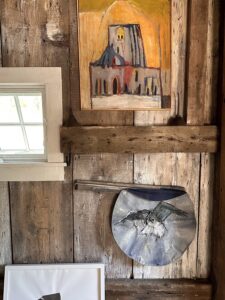
Q: Is there a throughline with the show that you can identify?
It is certainly about looking at the exterior world and being an observer. I say this word attitude a lot, because my interest is in someone looking at a piece and understanding the attitude of what they’re looking at. Whether it’s a gesture of a figure, or the emotional feeling of a landscape, or how something looks. But then also the way that paint, and not just paint, but different types of marks handle that. I like to say that I’m following a line.
Q: Hearing all this, it sounds like you’re assemblaging the barn in a way as well.
I find the barn space uniquely inspirational. It’s essentially a found object in and of itself. It guides my ideas about displaying work. I’m certainly interested in making art there, but then I ask, how is the work shown outside of that context? How is it framed or not framed? How do pieces bounce off each other in a room? I never imagined that my work would be in such a historic, weathered space. In these old places, I can’t help but think who in the past was looking at this patch of sunlight in this room at this same time of day. That notion of history and place is very deep and generative for me.
Between Abstraction and Reality
The event: 25 years of Megan Hinton’s work
The time: Through Oct. 20
The place: Provincetown Art Association and Museum, 460 Commercial St.
The cost: $15 general admission; free on Fridays after 5 p.m.
